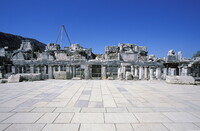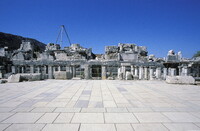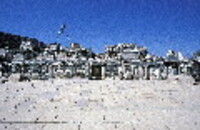| dc.coverage.spatial | Site: Ephesus, Aegean Region, Turkey | en_US |
| dc.coverage.temporal | ca. 50 BCE-400 CE (creation) | en_US |
| dc.creator | unknown (Greek (ancient) with Ancient Roman additions) | en_US |
| dc.date | -50-400 | en_US |
| dc.date.accessioned | 2013-02-26T20:50:31Z | |
| dc.date.available | 2013-02-26T20:50:31Z | |
| dc.date.issued | -50-400 | en_US |
| dc.identifier | 196430 | en_US |
| dc.identifier.other | archrefid: 1565 | en_US |
| dc.identifier.uri | http://hdl.handle.net/1721.3/103941 | |
| dc.description | Frontal view of the skene, looking north; Although Lysimachus is often credited with building the "Great Theatre" at this time, there is no evidence of a theatre in the initial construction phase of the city. Stefan Karwiese of the Österreichisches Archaologisches Insitut questions the existence of a theatre at Ephesus prior to 100 BC but acknowledges the possibility that Lysimachus may have chosen the building site prior to his death in 281 BC. The magnificent theatre is set into the side of a steep hill at the center of the ancient city. Its design, location and conception may have benefited from Hellenistic influences but its size and ornamentations are the products of Imperial Rome. The theatre was built at the end of the Hellenistic period, but it was significantly altered and enlarged by the Romans during the following five centuries. The theatre remained in use until the 5th century AD. The Roman cavea at Ephesus is larger than a semicircle, with three tiers of seats separated into wedges (cunei) by two diazomata and 58 staircases. The first tier of seats has twelve staircases, while the second and third tiers had twenty-three each. Made of marble, the cavea held 17,000 to 22,000 spectators and measured 140 by 95 meters. The steepness of the rows increases above each diazomata for the benefit of those sitting at the back of the theatre. There was a colonnade above and behind the uppermost tier of cavea seating. An awning (velum) that provided weather protection to the cavea was added in the middle of the second century AD. Source: Ancient Theatre Archive, Whitman College; http://www.whitman.edu/theatre/theatretour/home.htm (accessed 7/13/2008) | en_US |
| dc.format.medium | stone; marble | en_US |
| dc.rights | © Scott Gilchrist, Archivision, Inc. | en_US |
| dc.subject | architectural exteriors | en_US |
| dc.subject | recreation and games | en_US |
| dc.subject | festivals | en_US |
| dc.subject | Performing arts | en_US |
| dc.subject | Roman Empire | en_US |
| dc.subject | leisure | en_US |
| dc.subject | Hellenistic | en_US |
| dc.subject | Imperial (Roman) | en_US |
| dc.title | Ephesus: Theater | en_US |
| dc.title.alternative | Great Theatre at Ephesus | en_US |
| dc.type | image | en_US |
| dc.rights.access | Licensed for educational and research use by the MIT community only | en_US |
| dc.identifier.vendorcode | 1A3-R-T-E-16-C3 | en_US |
| vra.culturalContext | Greek (ancient) Ancient Roman | en_US |
| vra.technique | construction (assembling) | en_US |
| vra.worktype | theater (building) | en_US |
| vra.worktype | excavation (site) | en_US |
| dc.contributor.display | unknown (Greek (ancient) with Ancient Roman additions) | en_US |



